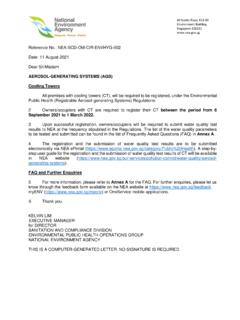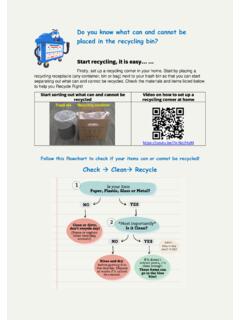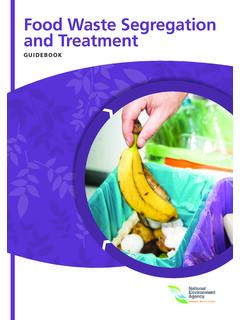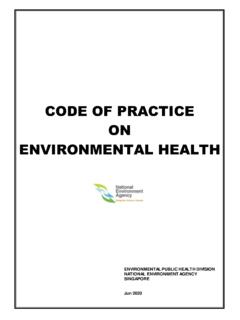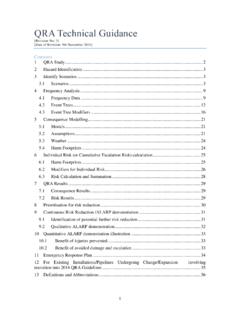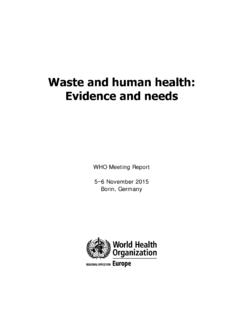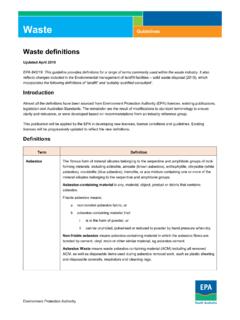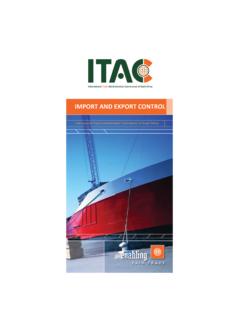Transcription of MANAGEMENT OF TOXIC INDUSTRIAL WASTES IN …
1 1 MANAGEMENT OF TOXIC INDUSTRIAL WASTES IN SINGAPORE 1 Introduction WASTES may be defined as materials which no longer can be used for the purposes they were intended for originally. TOXIC INDUSTRIAL WASTES are WASTES which by their nature and quality may be potentially detrimental to human health and/or the environment and which require special MANAGEMENT , treatment and disposal. In view of Singapore s small land area with limited land and water resources, the siting of industries has to be carefully planned and managed. In addition, industries are required to design their manufacturing processes and provide pollution control facilities to comply with pollution control requirements on emission of air pollutants, discharge of INDUSTRIAL effluent, MANAGEMENT of hazardous substances and TOXIC INDUSTRIAL WASTES .
2 There are currently more than 2,000 companies in Singapore which handle or use hazardous chemicals. The use of these chemicals generates a wide variety of TOXIC INDUSTRIAL WASTES . The main types are spent acids, spent solvents, spent etchants, waste oil and other waste sludge. 2 Strategy for control of TOXIC INDUSTRIAL WASTES The key elements in Singapore s strategy to control TOXIC INDUSTRIAL WASTES and ensure their safe treatment and disposal are as follows: (i) avoid generation of intractable WASTES ; (ii) encourage waste minimisation; (iii) encourage waste reuse, recovery and recycling; (iv) regulate collection, treatment and disposal; (v) monitor and audit collection, treatment and disposal; and (vi) promote and support educational and training programmes.
3 All new INDUSTRIAL developments are screened by PCD at the planning stage. One of the key areas checked in this screening 2 process is the generation and disposal of WASTES from proposed INDUSTRIAL developments. PCD will approve the proposed INDUSTRIAL development only if the WASTES generated could be safely disposed of in Singapore. This avoids the generation of intractable WASTES that cannot be safely disposed of in Singapore. In addition, PCD will require industries to use processes that minimise waste generation or facilitates the reuse, recovery and recycling of the WASTES . Industries also need to incorporate measures into the design of their facilities to ensure WASTES generated can be properly handled and managed.
4 At the building plan stage, checks are made to ensure that these measures are incorporated into the design of the plants. PCD has encouraged the setting up of specialised waste recycling, treatment, and disposal plants. There are currently about 100 such plants in Singapore, treating and recycling a wide range of TOXIC INDUSTRIAL WASTES . Some of the TOXIC INDUSTRIAL WASTES collected and recycled by these plants for reuse are discussed in Section 5. The setting up of specialised waste recycling, treatment and disposal plants serve to help industries, especially the smaller companies, which may generate small quantities of special WASTES but find it impractical or uneconomical to install, operate and maintain a waste treatment facility because of cost, lack of expertise or space constraint.
5 The collection, recycling, treatment and disposal of TOXIC INDUSTRIAL WASTES are controlled under the Environmental Public Health Act (EPHA) and the Environmental Public Health ( TOXIC INDUSTRIAL Waste) Regulations (TIWR). 3 The Environmental Public Health ( TOXIC INDUSTRIAL Waste) Regulations (TIWR) The control on the import, sale, supply, receipt, transport, treatment and disposal of TOXIC INDUSTRIAL (hazardous) WASTES are regulated under the TIWR. INDUSTRIAL WASTES controlled under the TIWR are listed in the Schedule of the Regulations as waste streams from specific INDUSTRIAL activities, WASTES with specified TOXIC components and as specific categories of WASTES .
6 The list includes spent acids, alkalis, WASTES containing gallium arsenide, spent etching solutions containing copper from printed circuit board manufacturing, etc. The list is at the Annex. 3 In order to facilitate controls and proper MANAGEMENT , the functions and responsibilities of key persons involved in handling of the TOXIC INDUSTRIAL WASTES are clearly delineated in the TIWR. The key persons include the following: (a) Generator of WASTES (b) Collector (c) Carrier or transporter (d) Driver The generator will have to treat the WASTES in an approved in-house waste treatment plant and dispose of the residues, if any, at NEA sanitary landfill site.
7 Alternatively, the generator can engage a licensed TOXIC INDUSTRIAL waste collector to collect his WASTES for treatment and disposal. A TOXIC INDUSTRIAL waste collector is a person who receives TOXIC INDUSTRIAL WASTES for storage, reprocessing, treatment and disposal. He has to obtain a licence from PCD to collect specific TOXIC INDUSTRIAL WASTES that are listed in his licence and confine his WASTES storage and treatment activities to approved premises and facilities. Written transport approval from PCD is also required for the transportation of WASTES in quantities which exceed those specified in the TIWR. The responsibilities of the following key persons in the transportation are clearly defined in the TIWR: (a) Consignor - the person who presents a consignment of controlled WASTES for transport.
8 The consignor can be either the generator or the licensed collector. Transport approval shall be obtained from PCD to transport the WASTES . (b) Carrier - the person who undertakes the transport of the controlled WASTES . He can either be the generator, the licensed collector or the transport company engaged by either one of them. (c) Consignee - the person who receives the controlled WASTES . He is usually the licensed collector. 4 (d) Driver - the driver of the vehicle transporting the TOXIC INDUSTRIAL WASTES . To prevent illegal dumping and disposal of TOXIC INDUSTRIAL WASTES , the movement of every consignment of WASTES from a generator through a carrier to a collector is tracked by means of an Internet-based electronic submission of consignment note system (known as the e-Tracking System).
9 4 Waste Minimisation The Waste and Resource MANAGEMENT Department (WRMD) of NEA is to formulate policies to promote and spearhead waste minimisation in Singapore. WRMD develops, promotes and oversees the implementation of programmes on waste minimisation and recycling. It also carries out studies to enhance waste recycling. WRMD together with PCD works closely with the industries to promote waste minimization. Some of the activities promoted by WRMD and PCD are as follows: (a) Waste Exchange NEA helps to link industries for exchange of WASTES . Waste to one company may be a resource to another. For example, waste alkali generated by one company could be used by another company to neutralise the acidic WASTES .
10 This would minimise the ultimate quantity of WASTES to be disposed of. (b) Use of Clean Technology At the planning consultation stage, NEA advises and encourages industries to use clean technologies which minimise waste generation. (c) Reuse and Recycling NEA encourages the recycling and reuse of WASTES and assists in the setting up of waste recycling plants. Some of the WASTES that are being recycled and reused in Singapore are discussed in Section 6. (d) Waste Audit NEA encourages those industries that generate large quantities of WASTES to carry out waste audit. A waste audit is designed to achieve maximum resource optimisation and 5 improved process performance.

